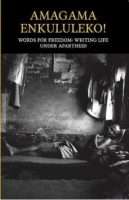The government declared a State of Emergency in 1985, which gave the police even greater authority to detain people without a charge, and protected the security forces from charges of abusing their powers. Many political detainees were tortured and killed. The president was given more power to bypass parliament, and more and more of the country’s affairs were being run by the heads of the army and police. The army went into townships to crush protests.
The State of Emergency lasted 8 months in 1985. In 1986 a new one was declared, which lasted the next 4 years. For a short time many townships became no-go areas for security forces; government had collapsed there. In this space there were calls for ‘people’s power’, and street committees and people’s courts were set up, often led by the youth. There was also violence directed towards people seen as informers or ‘sellouts’, and people’s courts punished township residents who broke consumer boycotts. But the army and police hit back, and fought battles with protesters on the streets of townships. The police detained as many as 44 000 people in the second State of Emergency. The UDF was banned. Secret Apartheid death squads tortured and killed political activists. The state also increasingly used local vigilante action to protect township councillors and attack members of anti-Apartheid organisations, with support from the police. Although the security forces managed to crush the rebellion by about 1987, they could not stop protests, which continued across the country.
By this stage a stalemate had been reached: the Apartheid government had run out of ideas after ‘Total Strategy’ failed, and parts of Apartheid, like separate Group Areas, were crumbling, but the liberation movement was not able to defeat it using force alone. Then suddenly in 1990, the new President, FW De Klerk, announced the unbanning of political parties like the ANC, PAC and Communist Party, and the release of political prisoners. This had a number of causes: the huge internal liberation movement, massive international pressure and sanctions, the very weak economy – and very importantly, the fall of the Soviet Union. They had been a supporter of the ANC; De Klerk thought that the ANC would be weakened by their fall, and therefore that he would be in a more powerful negotiating position if he decided to start talks at this point.
Dissent within white society led by groups such as the Black Sash, the End Conscription Campaign and student organisations had succeeded in dividing whites and weakening support for Apartheid. At the same time the white elite had decided to stake the future of capitalist class rule and privilege on one-person-one-vote and government by the ANC. The forces of liberation debated whether to accept an end to Apartheid laws, or to push for a socialist revolution. The ANC leadership made democracy their immediate aim. Mandela and his comrades decided to negotiate, believing, probably correctly, that the alternative was an unwinnable racial civil war.
In late 1991 the Convention for a Democratic South Africa (CODESA) began. These negotiations would break down when the ANC pulled out in protest at police and army activity continuing unchecked. A huge point of controversy was so-called ‘Third Force’ activity. Since the 1980s there had been tension and violence between the UDF (later ANC) and Inkatha, the Zulu Nationalist party. This flared up into virtual civil war in the early 1990s, based mainly in Natal and on the Rand. The media portrayed this as the result of ethnic divisions, and the government used it to try weaken the ANC, and show that they were not the legitimate representatives of all black South Africans. However, the ANC argued that there was a Third Force involved in the violence – the state. The IFP did indeed receive funding and military training from the government, and were sometimes protected by the police. The conflict was complicated by economic and social tensions between township residents (who often supported the ANC) and migrant hostel dwellers (often members of Inkatha).
When the police supported Inkatha members attacking an ANC funeral in Boipatong in 1992, the ANC embarked on mass action around the country. However, this too ended tragically, when protesters in Bhisho were massacred by Ciskei security forces.
In 1993, with the spectre of further violence a distinct possibility, parties returned to the negotiating table. They agreed on democratic elections to be held in 1994, after which the major parties would share power for a five year transitional period. National liberation was in reach, although social justice and economic freedom would have to wait.


